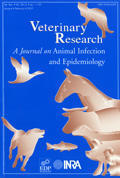Pigtrop - Le centre d'information sur l'élevage porcin et les filières porcines des pays du Sud
Vous êtes ici :
>
Ressources
>
Bibliothèque
>
Articles scientifiques
>
2006
>
Kristen Van Reeth, 2006
CIRAD © 2007 (Tous droits réservés) - Informations légales - Page mise à jour : 02/05/2009

Veterinary Research
An International Journal on Animal Infection and Epidemiology
Avian and swine influenza viruses: our current understanding of the zoonotic risk
Kristien VAN REETH